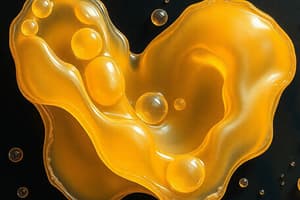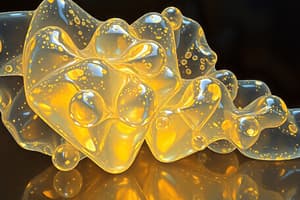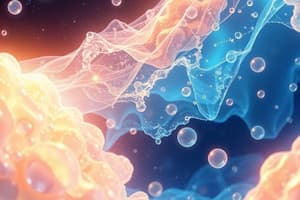Podcast
Questions and Answers
What is the purpose of adding Glutaraldehyde in the hydrogel synthesis process?
What is the purpose of adding Glutaraldehyde in the hydrogel synthesis process?
- To facilitate the swelling process
- To enhance the viscosity of the solution
- To act as a crosslinker (correct)
- To increase the temperature of the mixture
Which mathematical model was NOT used for estimating swelling kinetics parameters of CS hydrogels?
Which mathematical model was NOT used for estimating swelling kinetics parameters of CS hydrogels?
- Peleg's model
- Exponential association equation model
- Fickian diffusion model (correct)
- Non-Fickian diffusion model
In the context of swelling behavior analysis, what does percent equilibrium swelling indicate?
In the context of swelling behavior analysis, what does percent equilibrium swelling indicate?
- The initial volume of the hydrogel before swelling
- The rate of hydrogel degradation over time
- The maximum water absorption capacity of the hydrogel (correct)
- The amount of hydrogel mass lost during synthesis
How was the synthesis of CS hydrogels initiated according to the procedure described?
How was the synthesis of CS hydrogels initiated according to the procedure described?
How long were the contents mixed after adding Glutaraldehyde before hydrogel formation?
How long were the contents mixed after adding Glutaraldehyde before hydrogel formation?
What should happen to the test tubes after the hydrogel formation is observed?
What should happen to the test tubes after the hydrogel formation is observed?
Which of the following hydrogel shapes was NOT synthesized in the study?
Which of the following hydrogel shapes was NOT synthesized in the study?
What condition was maintained while retaining the test tubes after mixing the hydrogel?
What condition was maintained while retaining the test tubes after mixing the hydrogel?
What does the swelling fraction 'F' in hydrogel studies represent?
What does the swelling fraction 'F' in hydrogel studies represent?
Which equation is used to assess equilibrium swelling (ES%) of hydrogel?
Which equation is used to assess equilibrium swelling (ES%) of hydrogel?
Which characteristic indicates that hydrogel follows second order kinetics of absorption?
Which characteristic indicates that hydrogel follows second order kinetics of absorption?
What does the parameter 'n' represent in the equation F = Seq = k * t^n?
What does the parameter 'n' represent in the equation F = Seq = k * t^n?
What method was employed to characterize CS hydrogels in the study?
What method was employed to characterize CS hydrogels in the study?
What is the role of glutaraldehyde in the synthesis of CS hydrogels?
What is the role of glutaraldehyde in the synthesis of CS hydrogels?
Which factor does Fick's law consider in the description of diffusion in polymeric networks?
Which factor does Fick's law consider in the description of diffusion in polymeric networks?
In the context of hydrogel swelling behavior, what does 'Seq' refer to?
In the context of hydrogel swelling behavior, what does 'Seq' refer to?
What effect does increasing pH have on the swelling of chitosan hydrogels?
What effect does increasing pH have on the swelling of chitosan hydrogels?
Which factor most significantly contributes to the decrease in swelling at alkaline pH?
Which factor most significantly contributes to the decrease in swelling at alkaline pH?
How does crosslinking concentration affect the swelling behavior of the hydrogels?
How does crosslinking concentration affect the swelling behavior of the hydrogels?
What shape of hydrogels was chosen for further assessment due to good swelling and handling characteristics?
What shape of hydrogels was chosen for further assessment due to good swelling and handling characteristics?
What is the approximate pKa value of chitosan, indicating its behavior as a weak polybase?
What is the approximate pKa value of chitosan, indicating its behavior as a weak polybase?
In the study, what was accepted as the optimal temperature for maximum swelling of the hydrogels?
In the study, what was accepted as the optimal temperature for maximum swelling of the hydrogels?
Identify the main reason for the reduced swelling when 0.6mL of crosslinker was used?
Identify the main reason for the reduced swelling when 0.6mL of crosslinker was used?
What was noted about the swelling when comparing acidic and alkaline pH levels?
What was noted about the swelling when comparing acidic and alkaline pH levels?
Flashcards
Swelling Ratio (SR)
Swelling Ratio (SR)
The ratio of the weight of a swollen sample to the weight of a dry sample.
Second-Order Kinetics
Second-Order Kinetics
A type of reaction where the rate depends on the concentration of two reactants.
Equilibrium Swelling (ES%)
Equilibrium Swelling (ES%)
The percentage of swelling a hydrogel reaches when it's in equilibrium with a solution.
Fick's Law
Fick's Law
Signup and view all the flashcards
Swelling Fraction (F)
Swelling Fraction (F)
Signup and view all the flashcards
Fourier Transform Infrared Spectroscopy (FTIR)
Fourier Transform Infrared Spectroscopy (FTIR)
Signup and view all the flashcards
Swelling Kinetics
Swelling Kinetics
Signup and view all the flashcards
Crosslinked Chitosan Hydrogel
Crosslinked Chitosan Hydrogel
Signup and view all the flashcards
Effect of pH on Swelling
Effect of pH on Swelling
Signup and view all the flashcards
Effect of Crosslinker Concentration on Swelling
Effect of Crosslinker Concentration on Swelling
Signup and view all the flashcards
Chitosan (CS) as a polyelectrolyte
Chitosan (CS) as a polyelectrolyte
Signup and view all the flashcards
Temperature's effect on swelling
Temperature's effect on swelling
Signup and view all the flashcards
Hydrogels
Hydrogels
Signup and view all the flashcards
Crosslinker concentration
Crosslinker concentration
Signup and view all the flashcards
Effect of deacetylation on swelling
Effect of deacetylation on swelling
Signup and view all the flashcards
Chitosan (CS)
Chitosan (CS)
Signup and view all the flashcards
Crosslinking
Crosslinking
Signup and view all the flashcards
Glutaraldehyde
Glutaraldehyde
Signup and view all the flashcards
Equilibrium Swelling
Equilibrium Swelling
Signup and view all the flashcards
Peleg's Model
Peleg's Model
Signup and view all the flashcards
Exponential Association Equation
Exponential Association Equation
Signup and view all the flashcards
Study Notes
Kinetics, Absorption, and Diffusion Mechanism of Crosslinked Chitosan Hydrogels
- Chitosan hydrogels are useful in various environmental applications.
- Crosslinked and physical chitosan hydrogels were synthesized and their swelling compared.
- Square film shaped hydrogels swelled up to 3000%, but lacked rigidity and dissolved in mild acids.
- Crosslinked hydrogels increased in mechanical strength with higher crosslinker concentrations, but absorbed less water.
- Characterization of the synthesized crosslinked hydrogels was done using FTIR, TGA, and DSC.
- Equilibrium swelling was higher at acidic pH (2.5).
- Swelling increased with temperature increase.
- Swelling was higher with lower molar salt concentrations.
- Second-order kinetics was observed due to stress relaxation of polymeric chains.
- Anomalous diffusion was observed with exponent values between 0.5 and 1.
- Peleg's and Exponential association models were used for absorption modeling.
- Swelling ability, biocompatibility, and availability of oxygen and nitrogen on the CS surface make it suitable for drug delivery, controlled fertilizer release, and contaminant adsorption.
Introduction
- Hydrogels are 3-dimensional hydrophilic polymeric networks.
- Water acts as a dispersion medium in hydrogels.
- Superabsorbent polymers are a type of hydrogel with high water absorption (>100%).
- Hydrophilicity in hydrogels is due to polar groups like -OH, -CONH-, -COOH, and -SO3H.
- Hydrogels can be synthetic or natural polymer based.
- Examples of synthetic polymers include acrylic acid, acrylamide, polyurethane, and polyethylene glycol.
- Examples of natural polymers include polysaccharides like cellulose, dextran, starch, and chitosan (CS).
- Most commercial superabsorbents are acrylate based and take years to degrade.
- Toxicity and biodegradability are important factors for industrial applications.
- CS is a cationic biopolymer with formula β(1,4)2-amino-2-D-glucose.
- CS is biocompatible, biodegradable, and abundant.
- CS lacks mechanical strength compared to synthetic polymers.
- Crosslinking or blending with other polymers improves mechanical strength and workability.
Materials and Methods
- Chitosan (CS), glutaraldehyde, and acetic acid were used.
- Different shapes like beads, films, and discs were synthesized with different glutaraldehyde concentrations.
- Swelling studies were conducted in different pH solutions, temperatures, and salt concentrations.
- FTIR, TGA, and DSC were used for characterization.
Results and Discussion
- Swelling ability varied among different hydrogel shapes and concentrations of crosslinker.
- Square film hydrogels swelled significantly (up to 3000%) but were fragile.
- Crosslinked disc-shaped hydrogels provided a good balance of mechanical strength and swelling capacity.
- Swelling was significantly influenced by pH and temperature.
- Ionic strength also affected swelling (lower concentrations led to higher swelling).
- Swelling kinetics were analyzed using first- and second-order models and Fickian diffusion.
- The best-fitting model for swelling kinetics was Peleg's model.
- Results showed anomalous diffusion, with diffusion coefficients and exponents varied considerably.
Studying That Suits You
Use AI to generate personalized quizzes and flashcards to suit your learning preferences.




